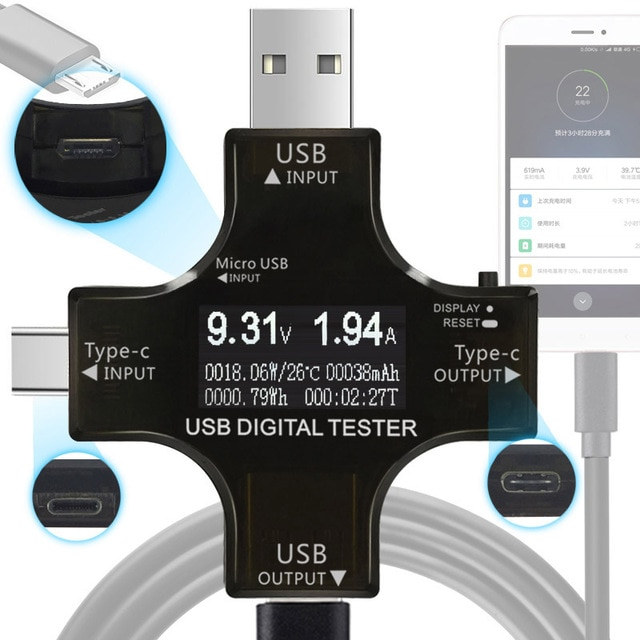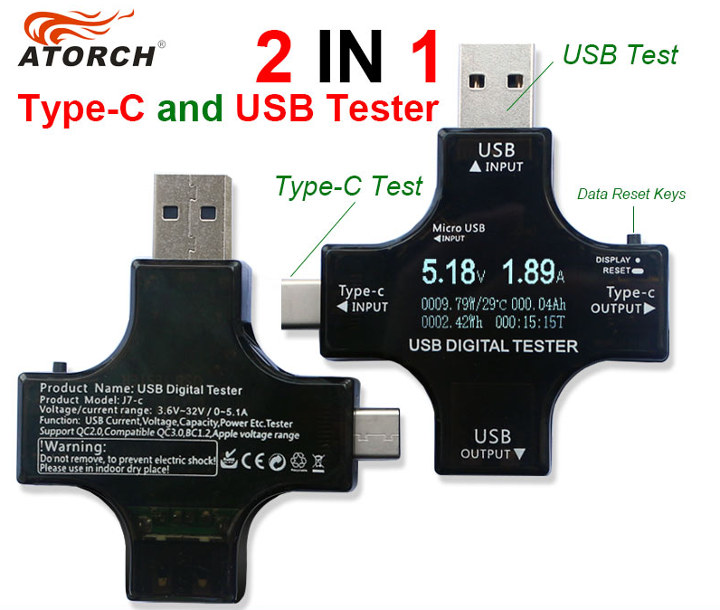Most smartphones are charged over a USB port, and many single board computers are powered by a micro USB or USB type-C port, and USB power meters such as USB Charger Doctor can be useful to evaluate phone chargers, as well as measure power consumption of SBCs.
With the launch of the USB type-C connector and features such as USB PD (Power Delivery), old USB power meters are not adapted to the new standard since the connector and most importantly voltages are different, so we need USB PD compatible meters like Satechi USB Type-C power meter. Today, I decided to look for more options on Aliexpress, and you’ll find many USB-C power meters with the cheapest models going for under $5 shipped. However, ATORCH J7-c model caught my attention since it supports both USB type-C, micro USB type-B, and USB type-A power sources, so you can keep using the same meter for all your USB testing needs.
ATORCH J7-c USB-PD power meter specifications:
- Display – 128×64 Dot matrix display with backlight
- USB Ports
- USB type-C input and output ports
- USB type-A input and output ports
- Micro USB input
- Fast Charging Standards – USB PD, Qualcomm QC 2.0 & QC 3.0, Android BC1.2, MTK-PE (5V / 7V / 9V / 12V), etc…
- Voltage Measurement Range – 3.6V to 32V
- USB D+/D- Voltage Range – 0 to 2.9V
- Current Measurement Range – 0 to 5.1A
- Energy Accumulation Range – 0 to 999,999 mAh
- Power Consumption Range – 0 to 999,999 mAh
- Time Range – 0 to 999 hours 59 minutes 59 seconds
- Dimensions – 6 x 6 cm
The display supports different display modes, as well as English and Chinese languages. If you are interested in ATORCH J7-c power meter, it’s currently sold for $7.22 including shipping.

Jean-Luc started CNX Software in 2010 as a part-time endeavor, before quitting his job as a software engineering manager, and starting to write daily news, and reviews full time later in 2011.
Support CNX Software! Donate via cryptocurrencies, become a Patron on Patreon, or purchase goods on Amazon or Aliexpress






Unfortunately not really suitable for Micro USB measurements.
I guess it could work with micro usb to usb cable …
Unfortunately not since you can only measure at the wrong end of the cable.
The ‘powered by Micro USB’ sh*t show is mostly related to a) the voltage drop happening in average (AKA crappy) Micro USB cables and b) normal users only looking at amperage ratings and being not familiar with such phenomenons like cable/contact resistance and Ohm’s law…
Take an average (crappy) Micro USB cable of 2m length and power something that needs 5W. On the irrelevant end of the cable the powermeter would show ‘5V @ 1A’ but on the only important other end of the cable it will be 4.4V or even lower depending on diameter of power lines in the USB cable used. You need a powermeter that can be directly inserted into the device’s Micro USB receptacle. Otherwise you are not able to measure the voltage drop caused by the cable. And this voltage drop is usually the culprit…
More details: https://www.cnx-software.com/2017/04/27/selecting-a-micro-usb-cable-to-power-development-boards-or-charge-phones/ — just looking at the voltage drop tables, especially with a 2A load, should be sufficient to get why measuring cable resistance is essential to understand in which way Micro USB powered devices suffer from ‘underpowering’ usually.
Maybe using a USB male to micro USB male adapter would do: https://www.ebay.com/itm/New-USB-2-0-A-Male-to-Micro-USB-B-Male-Plug-Adapter-Converter-M-M/391956890566 It would not expect it to have much resistance (hopefully)
Hmm… with such an adapter you might measure something but at least not the Micro USB cable in question (which is often the root cause of SBC instabilities).
That’s IMO one of the most annoying ‘support troubles’ with SBC that can’t be powered reliably: that average users don’t get what’s happening between PSU and board and instead waste their own and other’s time investigating/blaming software issues instead of fixing their voltage drop problem they’re not even aware of.
Not only relevant for Micro USB powered devices but also those using USB-C in ‘dumb mode’ like NanoPi M4 and NEO4 (USB-C without support for USB PD or Qualcomm’s QuickCharge that switch to higher voltages to avoid the voltage drop)
For those USB-C devices the above powermeter seems to be well suited but at ‘$7.22 including shipping’ I immediately put it into my ‘buy cheap, buy twice’ category. Would be nice to see a review of it somewhere…
Why are the M4 and Neo not capable of PD? Usb hubs or something else?
> Why are the M4 and Neo not capable of PD?
No idea. I would assume since both USB PD capable DC-DC circuitry adds a bit to BOM costs and good USB-C chargers that implement PD correctly are rather expensive?
Anyway: direct result of this is users complaining Armbian would be unstable compared to FriendlyELEC’s OS images due to Armbian allowing RK3399 to clock up to 2.0/1.5 GHz while FE is relying on RK3399 BSP defaults (1.8/1.4GHz). Those high DVFS operating points result in a lot more consumption for just a slight performance increase so… https://github.com/armbian/build/commit/abce2efea13e7845b53bc9336e85373bcc2ea746
You should set them as turbo frequencies only so that users can enable them manually but they are not used by default.
This looks like a more sane approach, thanks. Just to ensure I search in the right places… We would need
* operating-points-v2 compatbile entries
* mark the respective OPP as ‘turbo-mode’
* set
/sys/devices/system/cpu/cpufreq/boostto 0 but enable users to set it to 1What am I’m missing?
For understanding cables and voltage drop for sbc , I recommend Andreas Spiess #177 Avoiding suprises YouTube video from 6th Jan 2018.
If I click on the link I get a price of $ 8.35
You are better off paying a bit more and getting something like https://www.aliexpress.com/store/product/RD-TC64-Type-C-color-LCD-USB-Voltmeter-ammeter-voltage-current-meter-multimeter-battery-PD-charge/923042_32911231718.html or if you need to monitor the actual PD protocol, https://www.aliexpress.com/item/POWER-Z-USB-PD-Tester-QC3-0-2-0-Charger-Voltage-Current-Ripple-Dual-Type-C/32848590308.html
> aliexpress.com/store/product/RD-TC64-Type-C-color-LCD-USB-Voltmeter-ammeter-voltage-current-meter-multimeter-battery-PD-charge/923042_32911231718.html
This one can only measure at the wrong end of the cable (no way to measure the influence of cable resistance)
> aliexpress.com/item/POWER-Z-USB-PD-Tester-PD-Quick-Charger-Voltage-Current-Ripple-Dual-Type-C-KM001-Meter
404 — dead link but searching for ‘POWER-Z USB PD Tester KM001 Professional’ is sufficient.
I’ve fixed the second link in Adam’s comment.
Oops, thanks
I’m not sure what USB-PD compatibility means for such a device. I believe it only measures the voltage between VCC and GND and the Quick Charge/USB-PD negotiation is up to the connected device and the USB supply.
After reading comments I bougth these 2 alternatives (not received yet), in case it helps anyone:
https://es.aliexpress.com/store/product/8-in1-QC2-0-3-0-4-30v-Electical-power-USB-capacity-voltage-tester-current-meter/408984_32812273461.html
https://es.aliexpress.com/store/product/Digital-voltage-measuring-instrument-Multi-function-USB-Tester-type-c-interface-oltmeter-Ammeter-Voltage-Meters/2632051_32914923320.html